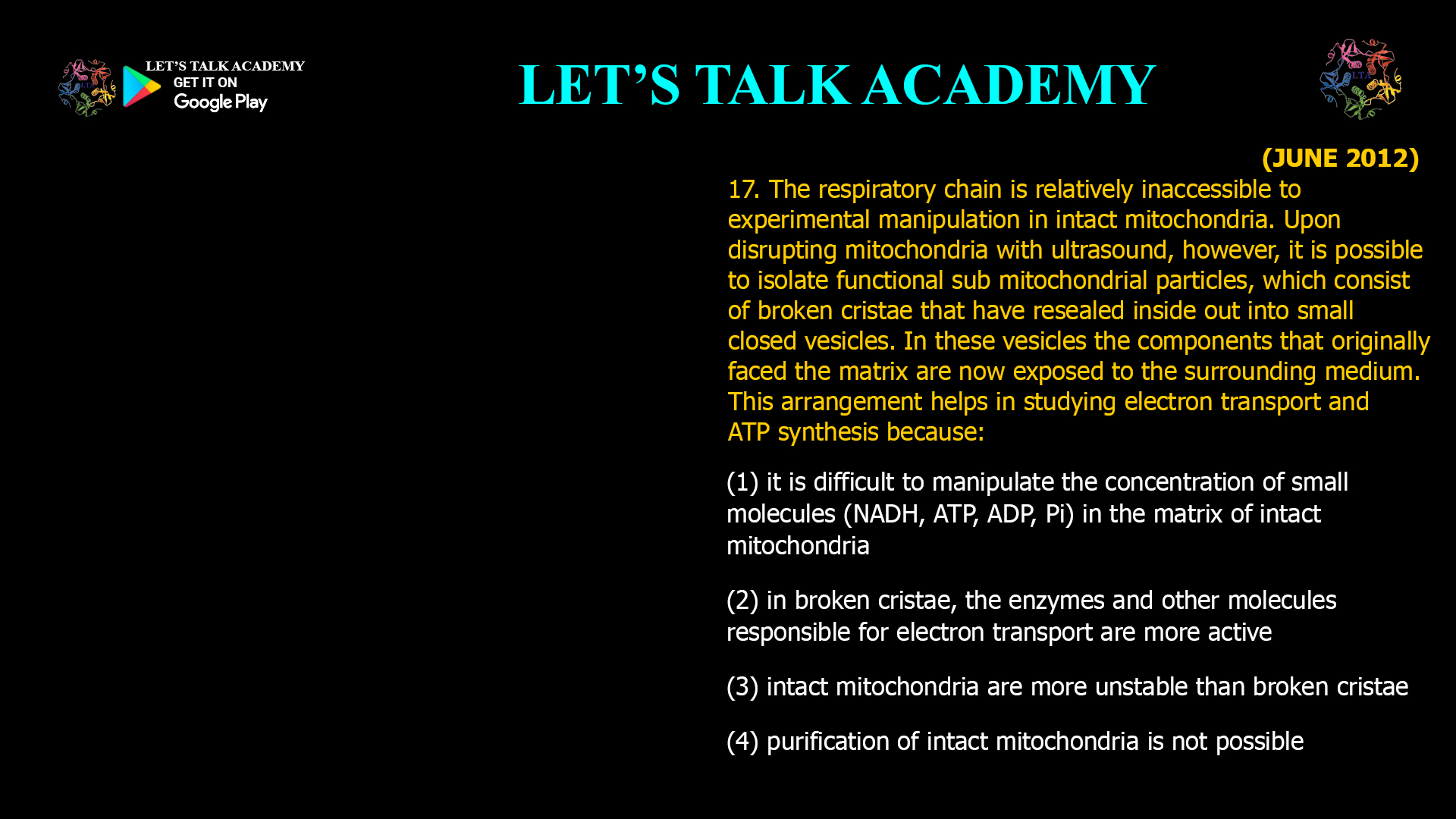17. The respiratory chain is relatively inaccessible to experimental manipulation in intact mitochondria. Upon disrupting mitochondria with ultrasound, however, it is possible to isolate functional sub mitochondrial particles, which consist of broken cristae that have resealed inside out into small closed vesicles. In these vesicles the components that originally faced the matrix are now exposed to the surrounding medium. This arrangement helps in studying electron transport and ATP synthesis because:
(1) it is difficult to manipulate the concentration of small molecules (NADH, ATP, ADP, Pi) in the matrix of intact mitochondria
(2) in broken cristae, the enzymes and other molecules responsible for electron transport are more active
(3) intact mitochondria are more unstable than broken cristae
(4) purification of intact mitochondria is not possible
In mitochondrial research, studying the electron transport chain (ETC) and ATP synthesis in intact mitochondria presents challenges due to limited accessibility of the mitochondrial matrix. To overcome this, scientists use submitochondrial particles (SMPs)—vesicles formed by disrupting mitochondria with ultrasound, resulting in inside-out vesicles exposing matrix-facing components to the external medium.
What Are Submitochondrial Particles?
-
SMPs are small vesicles derived from the inner mitochondrial membrane after disruption of mitochondria by sonication or other physical methods.
-
The inner membrane folds (cristae) reseal into closed vesicles with the matrix side facing outward.
-
This inversion exposes enzymes and components normally inside the matrix to the surrounding solution.
Why Are SMPs Useful for Studying Electron Transport and ATP Synthesis?
1. Accessibility of Matrix-Facing Components
-
In intact mitochondria, the matrix is enclosed by the inner membrane, making it difficult to control or manipulate concentrations of small molecules like NADH, ATP, ADP, and inorganic phosphate (Pi) inside the matrix.
-
SMPs expose these matrix-facing enzymes and cofactors to the external medium, allowing direct experimental manipulation of substrates and inhibitors.
2. Functional Electron Transport and ATP Synthesis
-
Despite disruption, SMPs retain functional electron transport chain complexes and ATP synthase.
-
This allows researchers to study electron flow, proton pumping, and ATP synthesis in a controlled, cell-free system.
Why Other Options Are Less Relevant
| Option | Explanation | Correctness |
|---|---|---|
| (1) it is difficult to manipulate the concentration of small molecules (NADH, ATP, ADP, Pi) in the matrix of intact mitochondria | Correct; this is the primary reason SMPs are used. | Correct |
| (2) in broken cristae, the enzymes and other molecules responsible for electron transport are more active | Activity is generally preserved but not necessarily increased. | Incorrect |
| (3) intact mitochondria are more unstable than broken cristae | Intact mitochondria are generally more stable physiologically. | Incorrect |
| (4) purification of intact mitochondria is not possible | Purification of intact mitochondria is routinely done. | Incorrect |
Summary
Submitochondrial particles are valuable experimental tools because they allow:
-
Direct access to matrix-facing components of the electron transport chain and ATP synthase.
-
Manipulation of substrate and inhibitor concentrations that is difficult in intact mitochondria.
-
Functional studies of oxidative phosphorylation in a simplified system.
Final Answer:
(1) It is difficult to manipulate the concentration of small molecules (NADH, ATP, ADP, Pi) in the matrix of intact mitochondria




5 Comments
Pallavi Ghangas
September 23, 2025) it is difficult to manipulate the concentration of small molecules
Kirti Agarwal
September 24, 2025Statement A
Roopal Sharma
September 25, 2025It is difficult to manipulate the small molecules .
Heena Mahlawat
September 25, 2025It is difficult to manipulate the concentration of smalll molecules in the matrix of intact mitochondria
Kajal
October 5, 2025Option 1 is correct